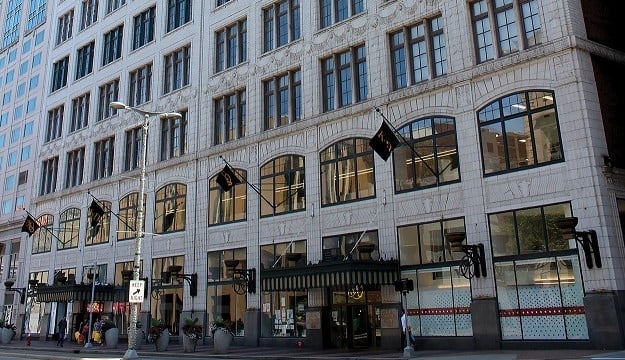BETHESDA, MD-Walker & Dunlop has made some $73 million in floating-rate interim loans since it launched this particular program last year. More than likely that number will grow as W&D adds to the platform. But don't expect to see a significant amount of lending in W&D's hometown—the demand just isn't there, Sandor Biderman tells GlobeSt.com.
This is not necessarily a bad sign for the area, Biderman continues. Rather, it is indicative of the fact that the city and surrounding area is further along in the current cycle than the rest of the nation. "We reached bottom earlier than the rest of the country and have made a faster comeback," he says.
Markets that are clamoring for rehab loans are not doing much new construction. For that reason, it is easier to find more attractive yields for value-add projects elsewhere.
That is not to say there is a total lack of demand for this type of money. To cite a few major examples: at the start of the year Jones Lang LaSalle's Capital Markets team secured $72 million in bridge financing for 1951 Kidwell Dr. and 1953 Gallows Rd., office buildings in Vienna, VA. The assets were part of a portfolio managed by Lowe Enterprises Investors on behalf of a national commercial commingled investment fund. A company sponsored by NorthStar Realty Finance Corp. provided the financing for the two buildings, which at the time of closing were 72% leased.
That said, Biderman notes that whatever activity takes place is DC is more than matched elsewhere in the US. "DC is a less active market for what we are seeing around the rest of the country," he says.
Biderman, though, is speaking of W&D's particularly bailiwick: short-term funding for projects that don't necessarily meet the GSE's or HUD's finance requirements now, but have an exit strategy in sight. In other words, your standard lending scenario for interim finance.
A new type of gap finance is appearing here and there in the market nationwide; interim finance that is better suited for DC's particular circumstance: ground up construction for mezz finance.
Before we examine this trend in depth, though, it is worth a look at why it is starting to emerge.
Despite all expectations to the contrary a few years ago, mezz providers are finding it harder to reap returns on traditional mezz lending and thus are looking for less traditional structures and projects to underwrite. For companies like Pembrook Capital Management in New York City, that means ground-up construction mezz finance, which can theoretically deliver roughly a double-digit return. "This is one of the new directions in which mezz financing is headed," says managing director John Garth.
Dynamics in the market that are bringing about this change include:
- Asset values have risen enough to mitigate the gap exposure that existed with basic properties during the depth of the recession. A few months ago, Green Street Commercial Property Price Index officially marked property values' recovery to pre-recession levels.
- A number of new entrants in the interim finance market--one example being Walker & Dunlop—which have added pressure on providers.
- A realignment of the capital market stack with senior lenders becoming more aggressive and lending higher in the stack. "Three years ago they were at 60% loan-to-cost," Garth says. "Now it is 65% to 75%. Also, I'm seeing the mezz piece getting smaller and going into more secondary and stronger tertiary markets."
- The uncertainty around interest rates.
Constantly Morphing Structures
"It's surprising how quickly the gap-financing market went from awful to fabulous," Clayton Gantz, a partner at Manatt, Phelps & Phillips says. "Bridge financing is being provided in contexts where I am not used to seeing it provided.”
"Structures, deals and offerings are constantly morphing," says Jerry Swartz of HKS Capital Partners LLC in New York City. "Every day, it seems, there is something a little different available on the market."
It is the same old, but still evergreen, story, he continues: "There's a lot of capital out there looking for a home, and gap financing is a very viable investment."
"It's surprising how quickly the gap-financing market went from awful to fabulous," Clayton Gantz, a partner at Manatt, Phelps & Phillips says. "Bridge financing is being provided in contexts where I am not used to seeing it provided.”
"Structures, deals and offerings are constantly morphing," says Jerry Swartz of HKS Capital Partners LLC in New York City. "Every day, it seems, there is something a little different available on the market."
It is the same old, but still evergreen, story, he continues: "There's a lot of capital out there looking for a home, and gap financing is a very viable investment."
Mezzanine for construction loans including ground up development is, as noted earlier, particularly well suited for the DC area. As Biderman pointed out, the area is further ahead in its development pipeline than other parts of the country--ground up construction and major renovations are very much a part of the landscape. To give just one example, last week workers began clearing a section of single-story retail at Fairmont and Norfolk avenues in Bethesda, MD, to make way the construction of 7770 Norfolk Ave., which will begin in September. The mixed-use project is a joint venture between The JBG Companies, ROSS Development & Investment and the CIM Group and is scheduled to deliver in mid-2015.
Swartz of HKS Capital Partners describes what mezzanine for construction loans likes like in a few projects the company has underwritten.
"We recently did a construction loan for a residential conversion in New York—it's a former school building on the Upper East Side that is being converted to an apartment. The construction loan is 65% LTC and the mezz piece came in at about 85% or so."
To stay competitive, Swartz offers 'good guy walkaway' guarantees, so the borrower doesn't have to provide a personal one. These are guarantees in which the borrower, if it can't complete the project, promises to hand over the keys and walk away.
"We are also able to do pari passu lending," he adds. "In most cases a construction lender requires the equity of the borrower, or the 35%, to go in first, on day one, before the lender will provide any funding. We have some lenders that will do pari passu, meaning the equity goes in with the lender's money, making it easier on the borrower."
The fact that mezz debt is being provided at all for construction—never mind the bells and whistles—is an eyebrow raiser, Gantz of Manatt, Phelps & Phillips says.
"Prior to this recent cycle I have never seen mezz debt in construction, and the fact that I am seeing it provided now leads me to believe that the pressure on these capital providers is greater than it ever has been."
The concern, he continues, is that competitive pressures will overtake caution and underwriting standards will start to erode.
"That, of course, is the subtext to all these transactions. It certainly was a major theme leading up to the crash—lenders get too aggressive, overleverage the properties and then everyone pays a price if the economy turns or fundamentals change."
Garth, for one, is aware of the risks and takes the proper risk mitigation measures. For example, the company passed on a number of new projects in Houston and Dallas that didn't offer a particular reason to jump in. “There are so many projects going up in those markets now, we are beginning to fear overbuilding," Garth says.
The risk mitigation processes were in overdrive when the company embarked on the ground-up mezz construction loan, a deal structure that was relatively new when it closed in the second half of 2012.
It was for a multifamily project in Silicon Valley, Garth reports. "Our piece in this project is about $15 million and the senior debt is about $30 million."
"There was a lot of things about the project we liked—the land basis was favorable, the developer is very strong and we felt that overall it was a well conceived project in a very strong location."
Garth says the company considers a wide range of factors before moving forward on any one project. “Construction is always a risky undertaking; that is going to be true no matter what the structure of a deal is."
© Touchpoint Markets, All Rights Reserved. Request academic re-use from www.copyright.com. All other uses, submit a request to [email protected]. For more inforrmation visit Asset & Logo Licensing.







